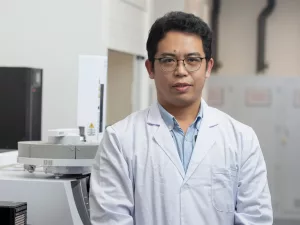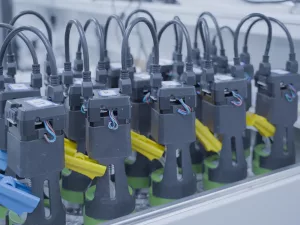A research team at UM has developed a system to recover high-value resources from sewage sludge produced by municipal sewage treatment plants. The system was introduced to the Macao public during the Science and Technology Week 2021 cum Exhibition of Achievements in Science and Technology Innovation, which was organised by the Science and Technology Development Fund of Macao (FDCT) and supported by the Ministry of Science and Technology. The system can extract industrial-grade sulfated polysaccharides from residual sludge of secondary clarifiers in sewage treatment plants. The extract can be broken down into useful substances such as industrial-grade sodium alginate, carrageenan, and potassium alginate. The team, which has received two Chinese patents for developing the system, has been in talks with several environmental engineering companies and venture capital firms about collaboration through UM’s Research Services and Knowledge Transfer Office (RSKTO).
In terms of technical maturity, the system has reached level 6 of the Technology Readiness Level (TRL), and tests conducted by an industrial partner have shown that the polysaccharides extracted by the system not only meet the Chinese quality standards for industrial-grade products; they can also produce algae products with the same degree of purity as those available on the market. The global demand for industrial-grade sulfated polysaccharides is growing rapidly, reaching USD 15.43 billion in 2021 alone. This contrasts with an acute shortage of conventional medical-grade sulfated polysaccharides, which are difficult and time-consuming to produce. ‘Our system can be used at a wide range of urban sewage treatment plants. If the system treats 100 tons of sewage sludge per day, we can obtain about 1,300 tons of sulfated polysaccharides in a year,’ says Hao Tianwei, head of the research team for the project. He is also an assistant professor at the Centre for Regional Oceans (CRO) and the Department of Civil and Environmental Engineering. ‘If we sell the polysaccharides at 60 per cent of the current market price for industrial-grade products, our annual revenue could exceed RMB 10.4 million.’
Through the CRO, Prof Hao’s team has continuously refined the process of extracting sulfated polysaccharides from sewage sludge in order to obtain medical-grade products. He points out that since 1987, when scientists discovered that sulfated polysaccharides could inhibit HIV, more potential functions of the polysaccharides have been revealed, such as the treatment of blood clots, immune inflammation, and tumours. ‘We have confirmed that sulfated polysaccharides extracted from sewage sludge have anti-tumour and anticoagulant effects,’ says Prof Hao.
‘Tons of sewage sludge are produced every day when treating domestic sewage and industrial wastewater. Instead of burning it, why not use it and turn the waste into high-value products?’ says Prof Hao, who also admits that by-products of sewage sludge are not yet widely accepted by the public due to prejudice. ‘As of today, only India allows the use of sulfated polysaccharides from sewage sludge for medical purposes. We need to make more efforts to promote these research results in order to change people’s minds.’
Source: UMagazine Issue 25
澳大團隊開發的市政污泥中高附加值資源回收系統在澳門科學技術發展基金主辦、國家科學技術部支持的「2021年科技周暨創科成果展」首次亮相。系統以污水廠二沉池剩餘的污泥為原料,提取和純化出工業級硫酸多糖,分離出工業級海藻酸鈉、卡拉膠、海藻酸鉀等產品,已獲兩項中國發明專利,正透過澳大的研究服務及知識轉移辦公室與多家環境工程及創業投資公司商討合作。
該系統技術成熟度達TRL6級別,從污泥提取的硫酸多糖經協力廠商檢測,品質滿足國家工業級硫酸多糖品質標準,純度與市售海藻產品相同。全球對工業級硫酸多糖的需求快速增長,其市場在2021年達154.3億美元。但傳統醫學級硫酸多糖生產複雜費時,全球嚴重供不應求。該研究項目負責人、區域海洋研究中心和土木及環境工程系助理教授郝天偉說:「我們的系統可廣泛用於城市污水處理廠。若每日處理100噸污泥,每年就可生產1,300噸硫酸多糖。以工業級硫酸多糖目前的市價60%來定價,估計每年收益可逾人民幣1,040萬元。」
研究團隊依托澳大區域海洋研究中心,不斷改良污泥提取硫酸多糖的工藝條件,以開發達醫學級別的提煉技術。郝天偉教授指出,自1987年科學家發現硫酸多糖可抑制愛滋病病毒之後,人們陸續發掘更多硫酸多糖的潛藏功能,如治療血栓、免疫性炎症和腫瘤。「我們證實了從污泥提取的硫酸多糖均具有抗腫瘤和抗凝血的活性功能。」
「城市每日處理生活污水和工業廢水時產生數以噸計污泥,與其焚燒它們,何不加以利用,把廢物變成高價值的產品?」郝天偉教授表示:「由於人們的刻板印象,污泥副產品仍待大眾接納,目前只有印度容許以從污泥提取的硫酸多糖作醫藥用途。有關研究仍需多作推廣,才能逆轉傳統思維。」
來源:《澳大新語》第25期

Prof Hao Tianwei
郝天偉教授

A system to recover resources from sewage sludge produced by municipal sewage treatment plants
市政污泥資源回收系統

